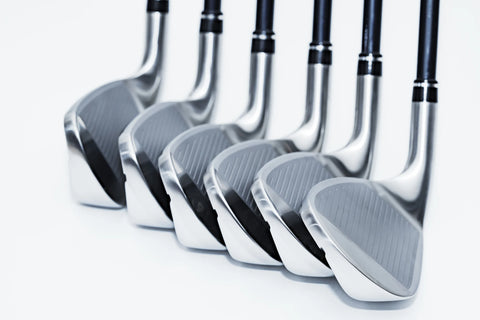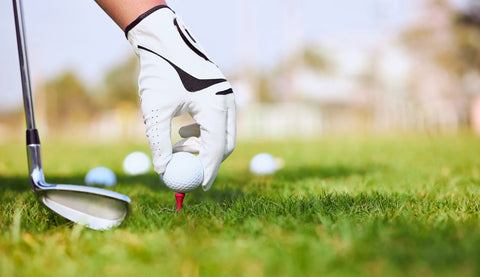For many golfers starting or who have been around the course several times, settling for a pre-assembled golf club set is the obvious choice, especially if a reputable brand creates it. And this is a perfectly fine choice to make. But what happens when you want more in your club or notice that the game got easier or remains fraught with mishits and poor-quality shots?
This is where customisation comes in, a game changer for any golfer looking for a tailored solution to their swing speed, gameplay style and skill level. Custom irons and other golf clubs mean you walk away with a set so perfectly aligned to you that it becomes an extension of yourself while out on the green.
This guide delves into the exciting world of iron customisation, exploring the key areas you can personalise to build your dream set.
Customisation Options
- Lofts: Loft refers to the angle between the shaft and the clubface, which affects distance and golf ball trajectory. Standard lofts vary by iron, with higher numbers corresponding to shorter distances and higher launch. Customisation allows you to modify these to better fit your swing speed and desired ball flight.
- Shafts: The shaft acts as the backbone of your iron, impacting feel, flex, and ultimately, ball control. You can choose between steel (known for durability and control) and graphite (lighter weight and often promoting higher launch). Shaft flex (how much the shaft bends on impact) is crucial, with stiffer flexes for faster swings and vice versa.
- Grips: Grips are the only point of contact between you and the golf club. The right size grip and material can dramatically affect the feel, swing mechanics, and clubface control. Thickness, material (rubber is the most common), and texture can all be modified for the golf club and player.
- Lie angle: This refers to the angle between the sole of the club and the shaft. Lie angle delivers consistently when striking the golf ball and ensures solid contact is made. Players with flatter swings may need flatter lie angles, while those with a steeper swing may benefit from more upright-angled golf clubs.

Exploring Customisation Options in Detail
Lofts
- Stronger lofts: These irons have lower loft angles compared to standard, resulting in longer distances but potentially higher ball flight. They are suitable for golfers with high swing speeds who already launch the ball high.
- Weaker lofts: These irons have higher loft angles, resulting in shorter distances but potentially more forgiving higher ball flights. They are suited for golfers with lower swing speeds or those seeking more forgiveness on off-center hits.
- Uniform gapping: This ensures a consistent distance difference between each iron. Customisation allows you to adjust lofts to achieve this, especially if your swing speed doesn’t quite match standard iron gapping. For example: If you find yourself hitting your 7-iron and 8-iron too close in distance, a gap fitting may be ideal.
Who Should Consider Loft Adjustments?
- High handicappers: If you struggle with distance, consider slightly strong lofts to boost yardage.
- Low handicappers: If you consistently overshoot greens, consider weak lofts for better control.
- Players with unique swings: An intense swinger might benefit from weak lofts to prevent ballooning, while a slower swinger could utilize strong lofts to bridge the distance gap.
Shafts
- Steel shafts: Provide more traditional feel and help golfers achieve better ball control. They are ideal for players with faster swing speeds or those seeking a more precise feel.
- Graphite shafts: These are lighter and often promote higher launch, making them a good choice for golfers with slower swing speeds or those wanting a more forgiving feel.
- Shaft flex: A too stiff shaft won’t bend enough at impact, leading to a loss of power and distance. On the other hand, a too soft shaft can cause excessive bend, resulting in inconsistency.
- Weight: Lighter shafts enable faster swing speeds but may feel less stable, while heavier shafts deliver more control but require more effort to swing.
How to Pick the Best Shaft?
- Get fitted: A professional fitting allows you to sample different shafts and see which delivers the most consistent ball flight and feel.
- Consider your swing speed: Match your flex to your swing speed. An expert fitting calculates your swing speed and suggests the best options.
- Feel is vital: While performance matters, prioritise comfortable shafts.
Grips
A good grip should feel comfortable in your hands, giving you maximum control over your swing; therefore, finding one that fits the size of your hand, preferred texture, and swing style is necessary.
Here are some key characteristics to consider…
- Size: Grips come in heaps of sizes, from standard to jumbo. Getting the right size ensures your hands are positioned correctly, and you have a comfortable, secure hold of the golf club.
- Material: Rubber is the most common material used for grips as it balances tackiness and durability. Some golfers prefer a softer or firmer feel; you’ll find grips made from leather, cord, and rubber compounds on the shelves of most golf shops.
- Texture: From smooth to ribbed, and corded, a grip’s texture influences feel and slip resistance. Choose a comfortable texture that provides a secure hold, especially in wet conditions and those hot days where sweat can impact grip.
Customising your grip can make a big difference to your swing and performance. Take the time to find the right fit!
How to Find the Perfect Grip?
- Speak to Golf 360: Our golf club fitters can measure your hand size and suggest grips that enable proper grip pressure.
- Consider your preference: Experiment with various materials and textures to find what feels most comfortable and secure.
Lie Angles
Lie angle refers to the tilt of the club when you address the ball. The right lie angle helps you make contact with the ball, which affects how it travels and how accurate your shots are.
To find the right lie angle, an expert can evaluate your posture and swing style. They can then modify your clubs so the clubface sits square at impact, helping you maximise your accuracy and distance.
Who Needs Lie Angle Adjustments?
- Players with swing tendencies: If you always hit shots with mishits, such as shanks or fat shots, lie angle adjustments may be worthwhile.

The Benefits of Customisation
- Accuracy and distance: Adjusting lofts to your swing speed ensures consistent gapping between irons, leading to more predictable distances.
- Feel and control: The proper shaft and grip blend promotes a more connected feel upon impact with the ball, leading to greater control over ball flight and the direction you wish the ball to travel.
- Confidence boosting: When your golf irons feel like an extension of you, it encourages confidence, allowing you to focus more on executing the perfect shot.
- Personalised look: With assorted grip colours and shaft finishes, you can customise your irons to reflect your style and personality.

Don’t Settle for Average
Golf sets are convenient, but picture having a set perfectly suited to your swing, style, and personality. At Golf 360, we stock a wide selection of top-brand golf irons that are designed to improve your distance and accuracy, and they are just waiting to be played!
Visit Golf 360 today and take the steps toward creating your one-of-a-kind golf club set. Browse our extensive online selection or schedule a personalised golf iron fitting service with our expert team!




